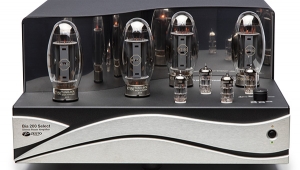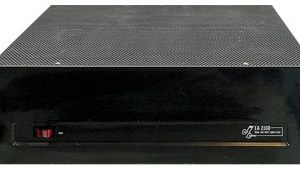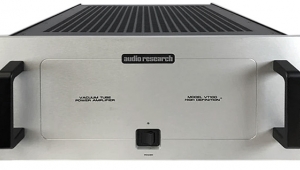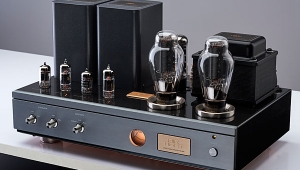| Columns Retired Columns & Blogs |
VTL MB300 & MB450 Signature monoblock amplifiers Chip Stern 2002
Chip Stern wrote about the MB450 Signature in October 2002 (Vol.25 No.10):
This Signature update of Vacuum Tube Logic's MB450 monoblock features a fully balanced input stage, remote voltage turn-on trigger, revised bias points and trim pots, new ground-loop circuitry, and a hair-trigger, fast-blow fuse for the B+ power rail, which (as I can attest to from several blown fuses) prevents a bad tube or a serious power anomaly from frying your circuits. Topping things off are a set of sophisticated new Multicaps in the signal path and to come, a pair of external-current inrush limiters, each requiring its own power cord. (My audition sample was not so equipped.)
With eight 6550 tubes per monoblock and an output stage that's switchable between 200W triode and 339W tetrode into 8 ohms, the MB450 also features a significantly larger version of the Signature Output Transformer than VTL's MB-175 (100W triode, 220W tetrode), which had offered me my only previous extended, in-home experience of VTL monoblocks. (That was in 1997, when I used a pair to review the Joseph Audio RM22si loudspeakers, along with a vintage Conrad-Johnson PV-5 line stage.)
In tandem with the VTL TL-5.5 tube line-stage preamplifier—review to appear next month—the MB450 monoblock evinced larger-than-life levels of midrange liquidity and dynamic drive, massive bass control, captivating high-frequency purity, and out-of-this-world, holographic layering and depth. I've never had anything in my system that delivered more goosebumps per square inch than this combo. The MB450 had all the textured majesty and dulcet intimacy I'd expect from more modestly configured triode amps, but with reserves of dynamic headroom that put SET amps to shame. More than equal to the demands of even so power-hungry a loudspeaker as the Joseph RM33si, the MB450 simply bristled with energy when coupled with more sensitive loudspeakers such as the Joseph RM7si and RM22si and the Meadowlark Shearwater. But I was even more impressed by how much sweeter and smoother the MB450's tetrode sound was than that of the MB-175, which tended to develop a touch of glare and midrange hardness when pushed.
Depending on the music and my mood, my tastes goes back and forth between warmth and brilliance, between a laid-back presentation and one that's in my lap and more deeply holographic. Older recordings and smaller-scale works benefited from triode's rich textural complexity, warm intimacy, and gentle, small-scale perspective, while more modern recordings and those with greater instrumental complexity profited from tetrode's transient speed, immense dynamic headroom, and the way it permitted a liquid descent into blackness.
At Home Entertainment 2002, I auditioned a much-touted, ludicrously configured SET colossus from Italy whose signal fell apart like a dry cracker when confronted with the enormous bass-drum transients in Valery Gergiev's recording of Stravinsky's The Rite of Spring (Philips 289 468 035-2). Playing that disc in triode or tetrode mode, the MB450 simply shrugged. Both modes had a rapturous midrange, but, top to bottom, triode was more centered and sweet, with greater air and inner detail; tetrode was more three-dimensional, if a touch less revealing, with a level of absolute authority in the low end that conveyed a sense of physical presence that must be experienced to be believed.—Chip Stern
- Log in or register to post comments



































